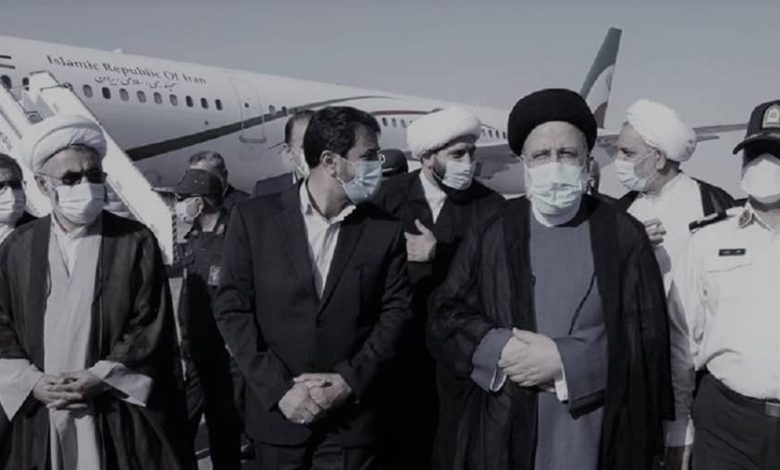Raisi’s Continues Provincial Trips Amid Iran’s Worsening Economic Crisis

Written by
Mahmoud Hakamian
The Iranian regime’s new president Ebrahim Raisi ended another of his provincial visits to Kohgiluyeh and Boyer-Ahmad Province Friday. While his trip was another bogus populists-gesture, he met angry people protesting his presence and delayed his entrance to the town.
“Angry and frustrated people blocked Raisi’s vehicle. They were outraged and restless,” wrote the official IRNA News Agency on October 1.
Raisi’s trip to Ilam and Tabas also failed in the last few months since his appointment as the regime’s president. People on each occasion poured on the streets and showed their hatred of the corrupted regime and its criminal president.
Public protests have been increasing in Iran in recent years due to the economic pressures they endure due to the mullahs’ institutionalized corruption. Hassan Rouhani’s administration ended its tenure with Iran’s economic crises deepening each year. Two major Iran protests in 2018 and 2019 that rattled the regime’s foundations initially started due to the economic crises.
Raisi as the henchman of the 1988 massacre, is responsible for the execution of over 30,000 political prisoners, mostly members, and supporters of the People’s Mojahedin Organization of Iran (PMOI/MEK)
He became the regime’s president, blaming the entire economic crisis on Rouhani and his government. It has been over three months since Raisi has assumed office, but besides continuing Rouhani’s “speech therapy” and giving some general recommendations, he has not taken any action.
“There have been no serious changes in the prices of people’s basic needs since the new administration started its work. In fact, the prices have been skyrocketing,” wrote the state-run Arman daily on September 28 in this regard.
According to the regime’s engineered statistics, since Raisi became president, the inflation rate has increased to %45.8. According to the state-run Farhikhtegan daily on October 2, “the number of Iran’s unemployed population has increased by has increased by more than one million and 310 thousand people compared to the summer of 2020.” The skyrocketing prices have increased people’s living costs from 40 million tomans per year in 2018 to more than 63 million tomans in 2021.
The poverty line has reached 10 million tomans. With a salary of 4 million tomans, the Iranian workers can hardly cover %30 of their living costs. This could happen if they receive their delayed wages.
According to official statistics, the price of an egg has reached 2,000 tomans, and the cost of red meat has increased 12 times in the last decade. The situation has reached a point that state-run Hamdeli daily acknowledged on October 2 that “People’s food security is at stake.”
Iranian people cannot afford food under the rule of mullahs
While Iranians suffer, the regime’s supreme leader, Ali Khamenei, refuses to address people’s problems or even mention them using his multi-billion-dollar financial empire. Raisi, who is Khamenei’s handpicked president, has refused to act and clings to his speech therapy and general yet futile recommendations.
As the economic crises deepened, public protests spread across Iran. These protests have prompted state media and officials to warn the regime about popular protests.
“If [the regime does not] act or think about the situation, we will face popular protests; Given the economic conditions of the majority of people, it is safe to say that the entire society lives below the poverty line. There is a limit to people’s patience in the face of difficulties, and people can endure to some extent. When they observe that they have nothing to lose, they do not want that we allow them to protest,” said the regime’s former MP, Soheila Jolodarzadeh, on Thursday, according to the state-run ILNA News Agency.
Some officials see the regime’s negotiations with the world powers and accepting the international community’s terms as the only cure to the current economic crises. Khamenei knows that this could be a temporary solution to the current crisis. But he knows that accepting another chalice of poison by stopping the regime’s terrorist activities or nuclear program would increase his regime’s infightings and losing power components. Besides, if the sanctions were removed due to the regime’s institutionalized corruption, Iran’s economic crisis would not end.
“If we look at the production cycle of the country, we can clearly see that all our production factories, including automobiles, home appliances, etc., complete their production cycle by importing raw materials. Therefore, there is no obstacle to the import of parts needed to produce the country’s factories, but why [the regime] not been able to solve the problem of distribution and employment in the country?” Jahan-e Sanat wrote on Wednesday, adding, “The fact is that the amount of production in the country is very low, which has caused the factories not to work at full capacity and not to create full employment. Therefore, we should not blame sanctions for our inefficiency.”
In other words, Khamenei and his regime are in a deadlock. Raisi would not resolve the current economic crises. He would, however, increase oppression, as he has done since assuming office in June with over 100 executions. This oppressive measure would also increase the restiveness of a society that sees regime change as the only solution to Iran’s endless crises.

